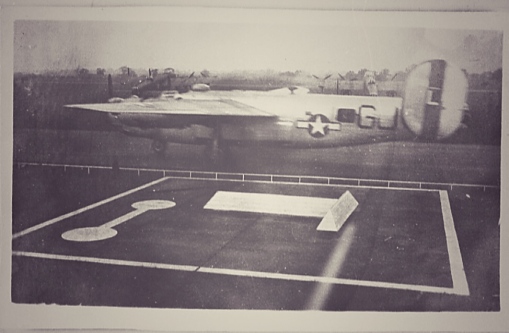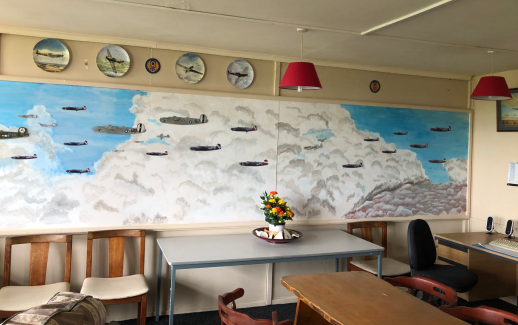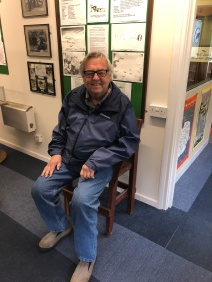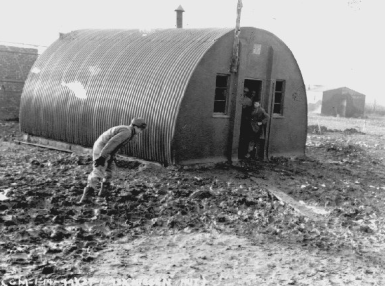In April, I set off on a three-week research trip in Europe following in the footsteps of my grandfather who flew B-24s from there during WWII. I would spend one day visiting the modern Shipdham Airfield, and I looked forward to this day more than any other.
(Note: In case you missed it, part one of this blog explains how we found ourselves at Shipdham and the long journey to get back there.)
In only eight hours at Shipdham, I had dozens of experiences, each lasting only a few moments, that have become treasured memories. This is thanks to three English gentlemen whose generosity in facilitating every aspect of our visit told of the deep bond built during the war between the English and the airmen. This bond remains intact today in spite of the 75 years that have passed.
Here are five moments from Shipdham that brought its wartime past into full view.
1. Driving down the remaining wartime runway.
 Getting to the Shipdham Flying Clubhouse requires driving down the one remaining wartime runway. This half-mile stretch of reinforced concrete was the literal launching point for the monumentally difficult task of strategic daylight bombing. As the rain slapped against Mike’s car and the potholes formed from this harsh climate jostled our bodies, I looked out the window lost in the scenes that unfolded here 75 years before.
Getting to the Shipdham Flying Clubhouse requires driving down the one remaining wartime runway. This half-mile stretch of reinforced concrete was the literal launching point for the monumentally difficult task of strategic daylight bombing. As the rain slapped against Mike’s car and the potholes formed from this harsh climate jostled our bodies, I looked out the window lost in the scenes that unfolded here 75 years before.
I was reminded of a letter Mike Whalen, the Radio Operator on my grandfather Wally’s crew, sent to Wally in 1998 when some fifty years after the war, his crew located him just before he died. Whalen recalled: “In 1976 I went to England and visited the base at Shipdham. […]. The main runway was still in place with grass growing up through cracks, a stack of hay in the middle of it, and cows grazing on the field. In the stillness, I could still feel the thrust of power as [Captain, Pilot] Emmett took us down that runway so many times headed out for Europe.”

Conjuring these words as we sped down the runway, I could see Wally’s crew in their silver B-24J named Bar L speeding alongside. Wracked by nerves in the lead up to a mission, they’d take off wondering if lady luck was on their side, but equally cognizant that whatever happened, it would be alongside this crew whose bond would be unshakable in their lifetime and the generations beyond.
2. Meeting the storied G-Fizz that foretold of our next adventure from Shipdham.

Early in our visit, Mike, the owner of Shipdham Flying Club, led us from the clubhouse to the hangar. Home to an impressive collection of warbirds and light aircraft, we ducked our heads to avoid hitting the wings and fuselages tightly packed in the hangar. Mike led us to the very back of the hangar to G-Fizz, his pride and joy that we’d heard much about on the way to Shipdham.
Previously owned by the Schweppes family, ‘Fizz’ pays homage to their empire of sparkling beverages. Mike brought G-Fizz, a four-seater Piper, back to life. My dad’s lifelong love affair with aviation left him swooning over the hangar and G-Fizz’s impeccable condition. As we meandered back to the clubhouse, Mike whispered to me that he wanted to take my dad and I flying later in the week. He’d known us for two hours; this offer another resounding example of the innate bond built because of what Wally and his comrades did at Shipdham a lifetime ago. In that moment and all those since, Mike has exuded a generosity of spirit that is befitting of the place he loves to fly from – Shipdham.

Coincidentally, before we left for Europe, my dad called asking if we’d be able to take a flight from Shipdham during our visit. Even dreaming about taking off from the runway at Shipdham alongside my pilot dad and feeling Wally’s presence in the skies above made me emotional. Yet, I was sure it was not possible. Barry, John, and Mike were strangers who were already going out of their way to make our visit to Shipdham happen. Happily, I couldn’t have been more wrong, and our day flying from Shipdham exceeded my wildest dreams. (That story coming soon.)
3. The serendipity and shock of stumbling upon a never-before-seen photo of Wally’s crew in the skies over Europe.

Spending decades getting to know the veterans of the 44th personally, John retains a history of the 44th no book or database parallels. Perched on the edge of my seat for many hours, we (Barry, Mike, my Dad, & John) sat around a table in the clubhouse lost in conversation that jumped from Shipdham to the skies above and zig zagged from the war to the years after. As we talked, I paged through two photo albums John brought for me to peruse.

The worn leather covers printed with the Flying 8 Ball Emblem suggested his priceless collection was amassed over decades, not years. This hunch proved true as John told me many of these photos were gifted by 44th veterans. Paging through the album, the individual photos collectively told a visceral story of the group’s 344 missions that spanned nearly three years. I lingered over each photo, jogging my memory for any connection to the boys and bombers pictured.
Turning through the final pages of the album, I stopped at an image of a B-24J that was suspended in the clouds; the crispness of the image would fool you into thinking it wasn’t taken from another bomber speeding high above the earth. Nestled elegantly in a thick cloud formation, Bar L flew just to the right of another Liberator visible in the background. Glancing at the caption below it, something caught my eye: “Bar L 44-10524.” My heart racing, I re-read the caption over and over.

Nearly a month into combat, my grandfather’s crew was assigned a brand new B-24J after flying war weary B-24Ds on their early missions. Wally flew 28 missions, almost 75% of his tour in this sparkling tin can named Bar-L. It was through the bottom of this bomber that Wally was shot during Operation Varsity. Wally’s crew and 10 passengers would return to the United States after V-E day on this Liberator. And yet, I could never find an image of Bar-L. Photos of a crew’s bomber on the ground and in the air were commonplace; yet, I’d combed the digital annals of 44th history to no avail.

I could not have conceived of something as improbable as finding an image of Bar-L while visiting Shipdham. Examining the bomber more closely, I looked for a sign that I was wrong, that this wasn’t Wally and his crew.
The identity of a B-24 can be discerned through multiple markings: The direction and color of a painted stripe on the vertical stabilizer indicated the bomb group. The symbol above, below, or beside the bomber’s assigned “letter” (e.g. ‘L’) indicated the squadron the plane belonged to. The unique seven-digit serial number assigned to each bomber on the production line was painted on the vertical stabilizer. Staring at the image, I began checking the bomber’s markings – the group, squadron, serial number.
Each one checked out; this was in fact Bar L, and I was almost certainly staring at Wally and his crew in the skies over Europe.

Interrupting the conversation, I couldn’t help but blurt out the news. Around the table, I was met with looks of disbelief. “You’re kidding,” was my dad’s first response. John chimed in saying, “I got that photo from Elwood Matter.” I knew then without a shadow of a doubt this was Wally’s B-24, as Matter had flown later in the war on many missions with Wally. The clouds surrounding the bomber were a stark reminder of the context – the crew either en route to a bomb run or eagerly heading back to Shipdham – the very place I was sitting as I clutched the photo. The open-air right waist gun window and plexiglass covering the cockpit provided a portal inside Bar-L; I could so vividly imagine Wally and his crew inside that tin can far above the earth.
Not just a picture of Bar-L, this was a palpable depiction of Wally and his crew in the heat of battle. Turning toward my dad, I saw the tears welling in his eyes. 353 bombers flew at Shipdham during the war. The odds of finding Wally in John’s albums were slim to none. But Bar-L revealed herself at Shipdham, floating in the clouds of Fortress Europe on a mission that began and ended on the runway I sat 100 yards from me. The present and the past converged connecting three generations of our family together for the briefest of moments in this fateful place.
4. Wandering the 44th Bomb Group Museum and soaking up the history on the very site where it unfolded.

Shipdham Flying Club boasts a small but mighty museum preserving artifacts from the war and telling a deeply human history of the group. Built from the decades-long relationships formed between the 44th vets and the Shipdham Flying Club members, the museum adjacent to the clubhouse is a portal to the humans behind the 44th.
Bill Cameron, a decorated Commanding Officer of the 67th Squadron, was also an avid photographer who gave his collection to the museum. His photos share an intimate glimpse of life at Shipdham from the mundane days between missions to the tension before a mission set off. Dozen of his images are featured offering a deeply human glimpse at life on base from the vantage point of a man an airman. In one image, a snowy winter wonderland blanketing bikes and Nissen Huts is juxtaposed by the with the misery it posed for the airmen living in ostensible tin cans on a sprawling base.

The perimeter walls are blanketed with priceless artifacts donated by veterans and found on base post-war. Oxygen bottles, sheepskins, and navigational computers used in the skies above Fortress Europe line the walls. Barry and Mike have made no small effort to preserve the history of the group and honor the American airmen who they came to know as young boys during the war. Their dedication is evident in the myriad veterans who entrusted this museum with their most precious artifacts from the war.

Tucked in every nook is another treasure from the 44th. Needing to rest a sore leg, I suggested my dad sit for a moment in a chair beside the door. Our guide Barry ushered dad to the chair and nonchalantly added it was made by the ground crews during the war using bomb crates. A flak vest hung on the wall; as the name suggests, armor plates were sewn between the canvas to protect the mid-section from exploding shells. I struggled to lift it from the wall trying to imagine wearing this on top of 70+ pounds of other equipment in the cramped confines of a B-24.
The back room of the museum is lined with boxes and shelves of metal and twisted shrapnel pulled from Shipdham’s ground after the war. These are remnants from the all too frequent crashes on take off or landing; these are fragments left behind from ground crews who worked around the clock to repair bombers.
The museum at Shipdham is not grand or large. It’s an unadorned mosaic revealing the deeply human experience of waging war in the skies above Shipdham. A personal look at war because of the spectacular hospitality provided by the Flying Club to the scores of veterans who returned after the war.
5. Driving the sprawling base spotting the few remnants of the war, including the Control Tower.

Unsurprisingly, little remains at Shipdham from the war. The Army Air Force stood up and operationalized the Eighth Air Force at an unparalleled pace. The speed with which the airfields in East Anglia were activated, coupled with the dearth of construction workers in England made only mission-critical infrastructure the priority. Building the steel-reinforced runways that wouldn’t buckle under the 60,000 pounds B-24s was a colossal undertaking leaving little time, men, or materials for anything else. The bare minimum infrastructure would be built. Corrugated metal Nissen Huts fit the bill as they were pre-fabricated, requiring hours, not days, to assemble, and they made efficient use of the scant building materials available in wartime England. Used primarily for living quarters, Nissen Huts provided little protection from the notoriously harsh weather in East Anglia, and the airmen grew to loathe these ostensible tin cans. After the war, the Nissen Huts that covered the once bustling Eighth Air Force bases deteriorated with the decades as the war became a memory.

Yet, there was one standard structure at the bases that remains on most bases in some form: the control tower. This nerve center of operations perched on the edge of the runways necessitated and merited a sturdy structure from where missions could be orchestrated. A standard design was used for the Control Tower at every East Anglian base. Built from brick, the Control Tower boasted two stories, with a balcony wrapping around the second floor enabling Group officers to closely observe the movements of a mission, be it forming up or bombers returning from a mission with wounded aboard.

While Control Towers at bases like the 100th and 453rd have been restored to their former glory since the war, Shipdham’s Control Tower has weathered 75 years at nature’s mercy. Cordoned off on the modern industrial site of Falcon Cranes, it’s a shell of its former glory. But it remains the symbol of wartime Shipdham; its slow deterioration a reminder that we’ll never be closer to WWII than we are today, and the fragments that enable us to piece together singular stories from the war are fleeting.

Hi. It was lovely to read your comments on our great airfield and the people that manage it. I have holiday cottages near the airfield. These were the quarters for the USA airforce during WW11 and several of the properties have the murals painted on the walls. One is the Flying Eight Ball. We would have loved to shown them to you. Perhaps next time.
Kind regards
Lesley Adams
LikeLike
Hi Lesley,
Thank you so much for reaching out. It is lovely to hear from you, and I appreciate your note. We drove by the cottages when I was on the airfield, and I’ve since looked at the photos on your website several times. I am hoping to come back to England this spring. Regardless of exactly when I return, I do hope to meet you and see the cottages.
Best,
Mara
LikeLike
Hi Mara
Good to hear from you please contact us when you return as we would love to show you the murals here.
Best wishes
Lesley
LikeLike
Hi Mara
A lovely story! Just been visiting my parents over the past couple of days. My father was a young lad of around 10 when the 44th were in England and lived at Dereham-a few miles away from Shipdham. He showed me a piece of writing in which he describes how he and his friends cycled over to the end of the runway and watched the B24s take off on their missions. They returned several hours later to welcome the bombers back. It left a lasting impression on him which is evident in the writing. Best wishes. Mark
LikeLike
Mark, It’s just wonderful to hear from you. So glad you stumbled on my site and left a comment. If you’d be open to sharing the piece of writing about cycling over to Shipdham, I would love to see it. (My email is maratruslow@gmail.com) -Mara
LikeLike
I have just reread your story of yours and your Fathers visit to Station 115 Shipdham , and that Iwas able for n a small way to help . It wasn’t until you found -L in a photo in my album the Elwood Matter gave me with others brought together the history of Shipdham to life . Thoroughly enjoy meeting you and Dad
LikeLike
I too had the great fortune of visiting Shipdham in the summer of 2010. I can recall my father, Jack E. Baba of Chicago, IL talking about his experiences with the 44th. I walked the runway and visited the museum set up there. After the visit upon arriving home I sent a few of my fathers army-air force artifacts to the museum. My father was ground crew and trained and shipped out in September ’42 and returned to the states April of ’45. He also spoke of the walks through thick fog on his way into town. I also walked that same road when I visited. It was truly a great “bucket list” trip for me. I would enjoy emailing with anyone that had a parent or grand-parent in the 44th Bomb Group.
Dr. Tom Baba, Spring Grove, IL
drtombaba@gmail.com
847-533-8385
LikeLike
I just read your letter regarding the 44BG of Shipdham. My father, Richard Donald, was a B-24 pilot who flew 32 or 33 missions out of Shipdham.
He died when I was 21, so I don’t know a lot about his experiences. I do know that he was greatly affected by his experiences during the war, but he rarely spoke of those times.
I want to visit Shipdham, and would appreciate any advice/information you might have regarding a visit there.
Thank you so much!
Linda Donald Harris
LikeLike
I so enjoyed your piece on Shipdham . My father was a B-24 pilot, and flew 32 missions from that air field. He died when I was only 21, so I knew very little about his time there. I do know that those experiences had a huge affect on his life, though he rarely spoke of these.
Reading your article, I was brought to tears, feeling a closeness to my dad. I really want to visit Shipdham.
LikeLike
Hi Linda,
Thanks so much for your note! It’s so wonderful to hear from fellow families of those who served at Shipdham. Visiting East Anglia and Shipdham was an amazing experience, and I can’t encourage you enough to make the trip. I got your other messages on the Omeka site and will shoot you an email soon (my twins arrived over the weekend, so I’ll get back to you soon!).
-Mara
LikeLike